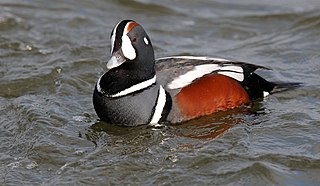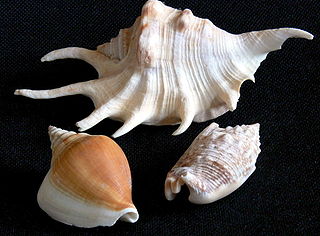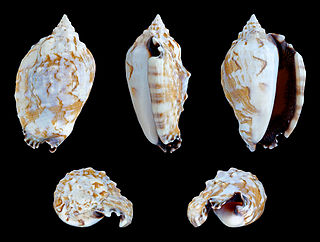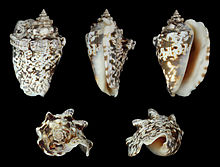Genus is a taxonomic rank used in the biological classification of living and fossil organisms as well as viruses, in biology. In the hierarchy of biological classification, genus comes above species and below family. In binomial nomenclature, the genus name forms the first part of the binomial species name for each species within the genus.

The seaducks (Mergini) are a tribe of the duck subfamily of birds, the Anatinae. The taxonomy of this group is incomplete. Some authorities separate the group as a subfamily, while others remove some genera. Most species within the group spend their winters near coastal waters. Many species have developed specialized salt glands to allow them to tolerate salt water, but these are poorly developed in juveniles. Some of the species prefer riverine habitats. All but two of the 22 species in this group live in far northern latitudes.

Balaenoptera, from Latin: balaena ('whale') and Ancient Greek: pteron ('fin'), is a genus of Balaenopteridae, the rorquals, and contains eight extant species. The species Balaenoptera omurai was published in 2003. Balaenoptera is a diverse genus and comprises all but one of the extant species in its family—the other species is the humpback whale.

Strombidae, commonly known as the true conchs, is a taxonomic family of medium-sized to very large sea snails in the superfamily Stromboidea. The term true conchs, being a common name, does not have an exact meaning. It may refer generally to any of the Strombidae but sometimes is used more specifically to include only Strombus and Lambis. The family currently includes 23 extant, and 10 extinct genera.

Strombus is a genus of medium to large sea snails, marine gastropod molluscs in the family Strombidae, which comprises the true conchs and their immediate relatives. The genus Strombus was named by Swedish Naturalist Carl Linnaeus in 1758. Around 50 living species were recognized, which vary in size from fairly small to very large. Six species live in the greater Caribbean region, including the queen conch, Strombus gigas, and the West Indian fighting conch, Strombus pugilis. However, since 2006, many species have been assigned to discrete genera. These new genera are, however, not yet found in most textbooks and collector's guides.

Tube-dwelling anemones or ceriantharians look very similar to sea anemones but belong to an entirely different subclass of anthozoans. They are solitary, living buried in soft sediments. Tube anemones live inside and can withdraw into tubes, which are composed of a fibrous material made from secreted mucus and threads of nematocyst-like organelles known as ptychocysts. Within the tubes of these ceriantharians, more than one polyp is present, which is an exceptional trait because species that create tube systems usually contain only one polyp per tube. Ceriantharians were formerly classified in the taxon Ceriantipatharia along with the black corals but have since been moved to their own subclass, Ceriantharia.

Lentigo maligna melanoma is a melanoma that has evolved from a lentigo maligna, as seen as a lentigo maligna with melanoma cells invading below the boundaries of the epidermis. They are usually found on chronically sun damaged skin such as the face and the forearms of the elderly.

A lentigo is a small pigmented spot on the skin with a clearly defined edge, surrounded by normal-appearing skin. It is a harmless (benign) hyperplasia of melanocytes which is linear in its spread. This means the hyperplasia of melanocytes is restricted to the cell layer directly above the basement membrane of the epidermis where melanocytes normally reside. This is in contrast to the "nests" of multi-layer melanocytes found in moles. Because of this characteristic feature, the adjective "lentiginous" is used to describe other skin lesions that similarly proliferate linearly within the basal cell layer.

Liver spots are blemishes on the skin associated with aging and exposure to ultraviolet radiation from the sun. They range in color from light brown to red or black and are located in areas most often exposed to the sun, particularly the hands, face, shoulders, arms and forehead, and the scalp if bald.

Neritidae, common name the nerites, is a taxonomic family of small to medium-sized saltwater and freshwater snails which have a gill and a distinctive operculum.

Corallimorpharia is an order of marine cnidarians closely related to stony or reef building corals (Scleractinia). They occur in both temperate and tropical climates, although they are mostly tropical. Temperate forms tend to be very robust, with wide and long columns, whereas tropical forms tend to have very short columns with a wide oral disc and very short tentacles. The tentacles are usually arranged in rows radiating from the mouth. Many species occur together in large groups, although there are recorded instances of individuals. In many respects, they resemble the stony corals, except for the absence of a stony skeleton. Morphological and molecular evidence suggests that they are very closely related to stony corals.
Ink spot lentigo is a cutaneous condition characterized by skin lesions commonly occurring on the shoulders. These lesions often cause alarm but are benign. They are an indication of excessive sun exposure so although ink spot lentigo is not premalignant, people with several of them maybe at increased risk of skin cancer due to UV damage. For a safe diagnosis, they must be flat. Although the shape is irregular, the structure as seen on dermoscopy is very homogenous.

Lentigo lentiginosus, common name the silver conch, is a species of medium-sized sea snail, a marine gastropod mollusk in the family Strombidae, the true conchs.

Lentigo pipus, common name : the Elegant Conch, is a species of Conch sea snail, a marine gastropod mollusk in the family Strombidae, the true conchs.
Austin Beatty Williams was an American carcinologist, "the acknowledged expert on and leader in studies of the systematics of eastern American decapod crustaceans".
Veloxidium is a genus of parasitic alveolates in the phylum Apicomplexa. Species in this genus infect marine invertebrates.
Corallimorphus niwa is a species of corals in the genus Corallimorphus. It was classified by Fautin in 2011. Corallimorphus niwa lives in marine habitats.

The Interim Register of Marine and Nonmarine Genera (IRMNG) is a taxonomic database which attempts to cover published genus names for all domains of life from 1753 in zoology up to the present, arranged in a single, internally consistent taxonomic hierarchy, for the benefit of Biodiversity Informatics initiatives plus general users of biodiversity (taxonomic) information. In addition to containing over 490,000 published genus name instances as at March 2020, the database holds over 1.7 million species names, although this component of the data is not maintained in as current or complete state as the genus-level holdings. IRMNG can be queried online for access to the latest version of the dataset and is also made available as periodic snapshots or data dumps for import/upload into other systems as desired.
Striatostrombus is an extinct genus of fossil sea snails, marine gastropod mollusks in the family Strombidae, the true conchs.

Heteropsammia is a genus of apozooxanthellate corals that belong to the family Dendrophylliidae.














